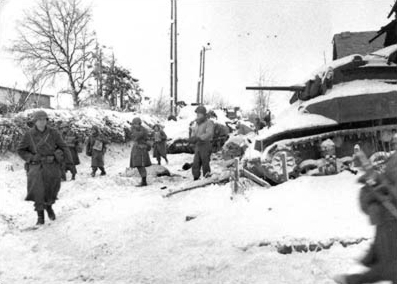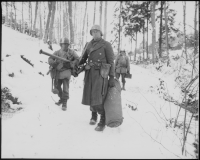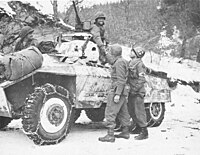
Battle of the Bulge
The Battle of the Bulge, also known as the Ardennes Offensive, was a major German offensive campaign on the Western Front during World War II which took place from 16 December 1944 to 25 January 1945. It was launched through the densely forested Ardennes region between Belgium and Luxembourg. The offensive was intended to stop Allied use of the Belgian port of Antwerp and to split the Allied lines, allowing the Germans to individually encircle and destroy the four Allied armies and force the western Allies to negotiate a peace treaty in the Axis powers' favor.
This article is about the 1944 German offensive in World War II. For other uses, see Battle of the Bulge (disambiguation).
The Germans achieved a total surprise attack on the morning of 16 December 1944, due to a combination of Allied overconfidence, preoccupation with Allied offensive plans elsewhere, and poor aerial reconnaissance due to bad weather. American forces were using this region primarily as a rest area for the U.S. First Army, and the lines were thinly held by fatigued troops and inexperienced replacement units. The Germans also took advantage of heavily overcast weather conditions that grounded the Allies' superior air forces for an extended period. American resistance on the northern shoulder of the offensive, around Elsenborn Ridge, and in the south, around Bastogne, blocked German access to key roads to the northwest and west which they had counted on for success. This congestion, and terrain that favored the defenders, threw the German advance behind schedule and allowed the Allies to reinforce the thinly placed troops. The farthest west the offensive reached was the village of Foy-Nôtre-Dame, south east of Dinant, being stopped by the U.S. 2nd Armored Division on 24 December 1944.[16] Improved weather conditions from around 24 December permitted air attacks on German forces and supply lines. On 26 December the lead element of Patton's U.S. Third Army reached Bastogne from the south, ending the siege. Although the offensive was effectively broken by 27 December, when the trapped units of 2nd Panzer Division made two break-out attempts with only partial success, the battle continued for another month before the front line was effectively restored to its position prior to the attack.
The Germans committed over 410,000 men, just over 1,400 tanks and armored fighting vehicles, 2,600 artillery pieces, and over 1,000 combat aircraft.[17] Between 63,000 and 104,000 of these men were killed, missing, wounded in action, or captured. The battle severely depleted Germany's armored forces, which remained largely unreplaced throughout the remainder of the war. German Luftwaffe personnel, and later also Luftwaffe aircraft (in the concluding stages of the engagement) also sustained heavy losses. In the wake of the defeat, many experienced German units were effectively out of men and equipment, and the survivors retreated to the Siegfried Line.
Allied forces eventually came to more than 700,000 men; from these there were from 77,000 to more than 83,000 casualties, including at least 8,600 killed.[18] The "Bulge" was the largest and bloodiest single battle fought by the United States in World War II[19][20][21] and the third-deadliest campaign in American history. It was one of the most important battles of the war, as it marked the last major offensive attempted by the Axis powers on the Western front. After this defeat, Nazi forces could only retreat for the remainder of the war.
While the German offensive toward the Meuse had ground to a halt by the end of December, they still controlled a dangerous salient in the Allied line. Patton's Third Army in the south, centered around Bastogne, would attack north, Montgomery's forces in the north would strike south, and the two forces planned to meet at Houffalize to reduce the bulge, and push east back toward the offensive start line.
The temperature during that January was extremely low, which required weapons to be maintained and truck engines run every half-hour to prevent their oil from congealing. The offensive went forward regardless.
Eisenhower wanted Montgomery to go on the counter offensive on 1 January, with the aim of meeting up with Patton's advancing Third Army and cutting off German troops at the tip of the salient, trapping them in a pocket. Montgomery, refusing to risk underprepared infantry in a snowstorm for a strategically unimportant area, did not launch the attack until 3 January. In addition, a series of renewed German attempts to re-encircle and seize Bastogne using units moved to the southern shoulder of the salient from the north, put Patton in a desperate fight for the initiative, with the German maintaining offensive operations in sectors north and east of Bastogne until 7 January, and resulting in heavier fighting than during the 21–26 December siege of Bastogne itself; in addition, Patton's Third Army would have to clear out the "Harlange Pocket" east of Bastogne on the Belgian-Luxembourg border.[118] One of these fierce actions around Bastogne occurred on 2 January, the Tiger IIs of German Heavy Tank Battalion 506 supported an attack by the 12th SS Hitlerjugend division against U.S. positions of the 6th Armored Division near Wardin and knocked out 15 Sherman tanks.[119]
At the start of the offensive, the First and Third U.S. Armies were separated by about 40 km (25 mi). American progress in the south was also restricted to about a kilometer or a little over half a mile per day.
On 7/8 January 1945, Hitler agreed to gradually withdraw forces from the tip of the Ardennes salient to east of Houffalize to avoid being cut off, but the Germans continued to resist in the salient and were only gradually pushed back otherwise. Considerable fighting went on for another 3 weeks, with Third Army and First Army linking up on 16 January with the capture of Houffalize. Sixth Panzer Army left the Ardennes and ceded its sector to the Fifth Panzer Army on 22 January, while St. Vith was recaptured by the Americans on 23 January, and the last German units participating in the offensive did not return to their start line until February.[120]
Winston Churchill, addressing the House of Commons following the Battle of the Bulge said, "This is undoubtedly the greatest American battle of the war and will, I believe, be regarded as an ever-famous American victory."[121]
Strategy and leadership
Hitler's chosen few
The plan and timing for the Ardennes attack sprang from the mind of Adolf Hitler. He believed a critical fault line existed between the British and American military commands, and that a heavy blow on the Western Front would shatter this alliance. Planning for the "Watch on the Rhine" offensive emphasized secrecy and the commitment of overwhelming force. Due to the use of landline communications within Germany, motorized runners carrying orders, and draconian threats from Hitler, the timing and mass of the attack was not detected by Ultra codebreakers and achieved complete surprise.[123]
Result
Although the Germans managed to begin their offensive with complete surprise and enjoyed some initial successes, they were not able to seize the initiative on the Western Front. While the German command did not reach its goals, the Ardennes operation inflicted heavy losses and set back the Allied invasion of Germany by several weeks. The High Command of the Allied forces had planned to resume the offensive by early January 1945, after the wet season rains and severe frosts, but those plans had to be postponed until 29 January 1945 in connection with the unexpected changes in the front.[174]
The Allies pressed their advantage following the battle. By the beginning of February 1945, the lines were roughly where they had been in December 1944. In early February, the Allies launched an attack all along the Western front: in the north under Montgomery, they fought Operation Veritable (also known as the Battle of the Reichswald); east of Aachen they fought the second phase of the Battle of Hürtgen Forest; in the center, under Hodges; and in the south, under Patton.
The German losses in the battle were especially critical: their last reserves were now gone, the Luftwaffe had been shattered, and remaining forces throughout the West were being pushed back to defend the Siegfried Line.[175][176]
In response to the early success of the offensive, on 6 January Churchill contacted Stalin to request that the Soviets put pressure on the Germans on the Eastern Front.[177] On 12 January, the Soviets began the massive Vistula–Oder Offensive, originally planned for 20 January.[178] It had been brought forward from 20 January to 12 January because meteorological reports warned of a thaw later in the month, and the tanks needed hard ground for the offensive (and the advance of the Red Army was assisted by two Panzer Armies (5th and 6th) being redeployed for the Ardennes attack).[179]
Churchill was elated at Stalin's offer of help,[180] thanking Stalin for the thrilling news.[181]
During World War II, most U.S. black soldiers still served only in maintenance or service positions, or in segregated units. Because of troop shortages during the Battle of the Bulge, Eisenhower decided to integrate the service for the first time.[182] This was an important step toward a desegregated United States military. More than 2,000 black soldiers had volunteered to go to the front.[183] A total of 708 black Americans were killed in combat during World War II.[184]
The Germans officially referred to the offensive by the codename Unternehmen Wacht am Rhein 'Operation Watch on the Rhine', while the Allies designated it the Ardennes Counteroffensive. The phrase "Battle of the Bulge" was coined by contemporary press to describe the bulge in German front lines on wartime news maps,[185][q] and it became the most widely used name for the battle. The offensive was planned by the German forces with utmost secrecy, with minimal radio traffic and movements of troops and equipment under cover of darkness. Intercepted German communications indicating a substantial German offensive preparation were not acted upon by the Allies.[187][188]
Bletchley Park post-mortem
Missed indicators
At Bletchley Park, F. L. Lucas and Peter Calvocoressi of Hut 3 were tasked by General Nye (as part of the enquiry set up by the Chiefs of Staff) with writing a report on the lessons to be learned from the handling of pre-battle Ultra.[190] The report concluded that "the costly reverse might have been avoided if Ultra had been more carefully considered".[191][192] "Ultra intelligence was plentiful and informative" though "not wholly free from ambiguity", "but it was misread and misused".[193] Lucas and Calvocoressi noted that "intelligence staffs had been too apt to assume that Ultra would tell them everything".[190] Among the signs misread were the formation of the new 6th Panzer Army in the build-up area (west bank of the Rhine about Cologne); the new 'Star' (signals control-network) noted by the 'Fusion Room' traffic-analysts, linking "all the armoured divisions [assembling in the build-up area], including some transferred from the Russian front";[194][192] the daily aerial reconnaissance of the lightly defended target area by new Arado Ar 234 jets "as a matter of greatest urgency"; the marked increase in railway traffic in the build-up area; the movement of 1,000 trucks from the Italian front to the build-up area; disproportionate anxiety about tiny hitches in troop movements, suggesting a tight timetable;[193][192] the quadrupling of Luftwaffe fighter forces in the West;[193] and decrypts of Japanese diplomatic signals from Berlin to Tokyo, mentioning "the coming offensive".[195][196]
SHAEF failures
For its part, Hut 3 had grown "shy of going beyond its job of amending and explaining German messages. Drawing broad conclusions was for the intelligence staff at SHAEF, who had information from all sources," including aerial reconnaissance.[r] Lucas and Calvocoressi added that "it would be interesting to know how much reconnaissance was flown over the Eiffel sector on the U.S. First Army Front".[190] E. J. N. Rose, head Air Adviser in Hut 3, read the paper at the time and described it in 1998 as "an extremely good report" that "showed the failure of intelligence at SHAEF and at the Air Ministry".[195][198] Lucas and Calvocoressi "expected heads to roll at Eisenhower's HQ, but they did no more than wobble".[199]
Five copies of a report by the Chief of the Secret Intelligence Service – Indications of the German Offensive of December 1944, derived from ULTRA material, submitted to DMI – were issued on 28 December 1944. Copy No. 2 is held by the UK National Archives as file HW 13/45.[200] It sets out the various indications of an impending offensive that were received, then offers conclusions about the wisdom conferred by hindsight; the dangers of becoming wedded to a fixed view of the enemy's likely intentions; over-reliance on "Source" (i.e. ULTRA); and improvements in German security. It also stresses the role played by poor Allied security: "The Germans have this time prevented us from knowing enough about them; but we have not prevented them knowing far too much about us".[201]
Battle credit
After the war ended, the U.S. Army issued battle credit in the form of the Ardennes-Alsace campaign citation to units and individuals that took part in operations in northwest Europe.[202] The citation covered troops in the Ardennes sector where the main battle took place, as well as units further south in the Alsace sector, including those in the northern Alsace who filled in the vacuum created by the U.S. Third Army racing north, engaged in the concurrent Operation Nordwind diversion in central and southern Alsace launched to weaken Allied response in the Ardennes, and provided reinforcements to units fighting in the Ardennes.


